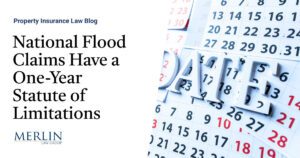Court Finds Duty To Defend Environmental Claim, But Defense Limited to $100,000
While agreeing with the insured there was a duty to defend, the court determined the defense of an environmental claims was limited to $100,000. Casa Nido Partnership v. JAE Kwon, 2023 U.S. Dist. LEXIS 97701 (N.D. Calif. June 5, 2023).
In 1976, Casa Nido purchased the property and remains the current owner to this day. Catherine O’Hanks owned and operated a dry-cleaning facility at the property from 1960 to 1992.
In August 2016, Casa Nido learned of Tetrachloroethylene (PCE) subsurface contamination. Casa Nido stipulated that it did not know, nor had any reason to know, before 2016, of the existence of the subsurface contamination. Casa Nido alleged that due to equipment malfunction or improper usage, there were sudden and accidental spills and equipment overflows of PCE during the 32-year period that defendant O’Hanks operated the dry-cleaning business on the property. Casa Nido spent hundreds of thousands of dollars remediating the environmental damage.
Casa Nido was an additional insured under O’Hanks’ policy with Sentry Insurance Company. The policies were effective from August 15, 1987 to August 15, 1990. Casa Nido sued O’Hanks and Sentry. Casa Nido alleged it was entitled to indemnification and contribution from O’Hanks under CERCLA.DO’Hanks counter-claimed against Casa Nido. Casa Nido tendere to Sentry, but Sentry determined there was no duty to defend or indemnify.
The court noted that whether the pollution occurred within the policy period depended on what the trigger of coverage was under the Sentry policies. Under the Dry-Cleaners Endorsement (DCE), the policies covered pollution-based property damage “[t]hat occurs during the policy period.” Property damage occurred when it “first manifests itself.” Under Montrose, the manifestation trigger was an objective “should have known” standard. Coverage was triggered at “that point in time when appreciable damage occurs and is or should be known to the insured, such that a reasonable insured would be aware that his notification duty under the policy has been triggered.” Montrose Chem. Corp. v. Admiral Ins. Co., 10 Cal. 4th 645, 674 (1995).
The court interpreted the DCE language consistent with Montrose. At the very least, the language of the policy regarding occurrence was ambiguous and had to be read in the insured’s favor. Under the policy and the DCE, “property damage” could ‘”occur” when there was a spill which resulted in contamination of the soil, Such property damage could occur each time there was such a spill. If discharges subsequent to the triggering discharge were continuous or repetitive of the triggering discharge, the subsequent discharges would be covered even if they first manifested outside of the policy period, as they would be considered part of a single occurrence that first manifested during the policy period. There was evidence sufficient to create an issue of fact regarding the nature and timing of the spills.
Therefore, Sentry had a duty to defend claims arising out of the discrete discharges and only those discrete discharges for which Casa Nido could establish a possibility of first manifestation during the policy period. If Casa Nido could demonstrate the mere possibility that a reasonable insured should have known of at least some PCE contamination during the policy period, and the contamination included a sufficiently discrete incident as to constitute an “occurrence” within the meaning of the DCE endorsement, there there was a potential for coverage, allowing Casa Nido to prevail on its motion for summary judgment as to Sentry’s duty to defend.
The defense, however, was limited to the $100,000 limit in the DCE.
Finally, the court granted Sentry’s motion for partial summary judgment on the bad faith claim. It was reasonable for Sentry to rely on Montrose and deny Casa Nido’s claims because the the manifestation trigger as defined by Montrose applied to the Sentry policies.




